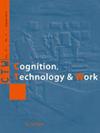Towards occupational resilience: A model to facilitate high school participation post traumatic brain injury.
IF 3.4
3区 工程技术
Q2 ENGINEERING, INDUSTRIAL
引用次数: 0
Abstract
BACKGROUND This article describes the model components of a study that applied a two-phased approach towards the development of an occupational resilience model. OBJECTIVE The occupational therapy practice model that is proposed seeks to facilitate high school re-entry and school participation post traumatic brain injury (TBI). The study's first phase generated results on participants' experiences of high school re-entry and school participation post TBI. These findings contributed to the second phase of developing a practice model to improve upon school transition practice for learners post TBI. METHODS The study's first phase comprised a qualitative multi-case study of eight cases. Data collection involved semi-structured interviews, participant and contextual observation, and document analysis. Data analysis was performed via an inductive process combined with cross-case synthesis. Phase 2 employed theory generation, suggesting an occupational therapy practice model for facilitating high school participation post TBI. RESULTS Participant responses revealed, following the onset of the TBI, a need for adolescents to display resilience in order to re-participate in school. This was displayed by adolescents adapting through drawing upon personal and environmental resources as well as preparing for and engaging in occupation. CONCLUSION A deeper understanding of the experiences of key role players involved in the school transition post TBI, combined with theory generation, formed the basis of developing the proposed model of occupational resilience. Occupational resilience, through a series of resilience-promoting tasks, is offered as a mechanism to increase learners' capacity to adapt to occupational challenges and meaningfully participate in school post TBI.迈向职业弹性:一个促进高中创伤性脑损伤后参与的模型。
本文描述了一项研究的模型组成部分,该研究采用了两阶段的方法来开发职业弹性模型。目的提出职业治疗实践模式,旨在促进创伤性脑损伤(TBI)后的高中重返和学校参与。该研究的第一阶段产生了参与者在创伤性脑损伤后重返高中和学校参与的经历。这些发现有助于开发实践模型的第二阶段,以改进TBI后学习者的学校过渡实践。方法研究第一阶段包括8例定性多病例研究。数据收集包括半结构化访谈、参与者和情境观察以及文献分析。数据分析通过归纳过程与交叉案例合成相结合进行。第二阶段采用理论生成,提出了促进高中学生创伤后参与的职业治疗实践模型。结果参与者的反应显示,在创伤性脑损伤发生后,青少年需要表现出适应力,以便重新参与学校活动。这表现在青少年通过利用个人和环境资源以及准备和从事职业来适应。结论对创伤性脑损伤后学校过渡过程中关键角色参与者经历的深入了解,结合理论的生成,构成了本文提出的职业弹性模型的基础。职业弹性通过一系列促进弹性的任务,作为一种机制来提高学习者适应职业挑战的能力,并有意意地参与TBI后的学校活动。
本文章由计算机程序翻译,如有差异,请以英文原文为准。
求助全文
约1分钟内获得全文
求助全文
来源期刊

Cognition Technology & Work
ENGINEERING, INDUSTRIAL-
CiteScore
6.90
自引率
7.70%
发文量
26
审稿时长
>12 weeks
期刊介绍:
Cognition, Technology & Work focuses on the practical issues of human interaction with technology within the context of work and, in particular, how human cognition affects, and is affected by, work and working conditions.
The aim is to publish research that normally resides on the borderline between people, technology, and organisations. Including how people use information technology, how experience and expertise develop through work, and how incidents and accidents are due to the interaction between individual, technical and organisational factors.
The target is thus the study of people at work from a cognitive systems engineering and socio-technical systems perspective.
The most relevant working contexts of interest to CTW are those where the impact of modern technologies on people at work is particularly important for the users involved as well as for the effects on the environment and plants. Modern society has come to depend on the safe and efficient functioning of a multitude of technological systems as diverse as industrial production, transportation, communication, supply of energy, information and materials, health and finance.
 求助内容:
求助内容: 应助结果提醒方式:
应助结果提醒方式:


